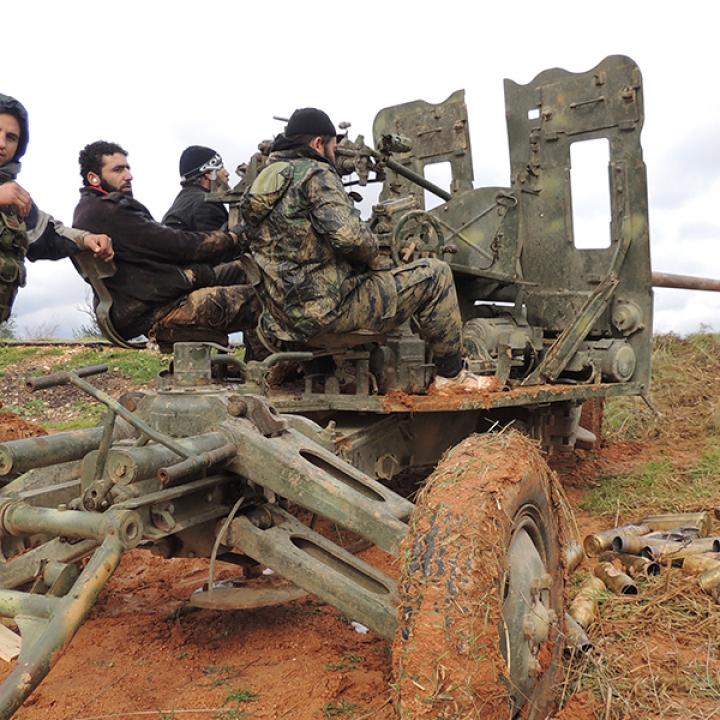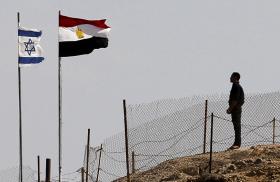

Increasingly well-armed rebels are a problem for the regime and could complicate the period after Assad's fall.
Rebel units in Syria can no longer be described as "lightly armed." Many have acquired heavy machine guns and antiaircraft guns, mortars, recoilless rifles, and artillery rocket launchers. Some also have tanks (see below) and BMP infantry fighting vehicles, while at least a few have shoulder-launched surface-to-air missiles (MANPADS), antitank guided missiles (ATGMs), and medium field artillery pieces. Most of these weapons were captured from regime stocks, and the rebels are increasingly employing them against Bashar al-Assad's forces. As the regime loses ground, the rebels will acquire significantly greater numbers of such weapons, boosting their capabilities still further.
This process has important implications for the war. Currently, it is tilting the battlefield against regime forces. And once Assad falls, possession of heavy weapons will help determine which rebels become the dominant military and political actors, likely increasing the difficulty of stabilizing the country in the long term.
REBEL HEAVY WEAPONS
For much of the war, armed opposition elements had only limited numbers of heavy weapons, mostly 23 mm ZU-23 light antiaircraft guns and "Dushka" heavy antiaircraft machine guns. Over the past few months, however, their arsenal has expanded, with rebels seizing weapons and ammunition from regime forces and stockpiles while producing some items on their own (e.g., artillery rockets, mortars, mortar bombs) (watch). Heavy weapons currently in their possession include:
- Armored vehicles: BMPs and T-55, T-62, and T-72 tanks
- Artillery (see below) or other indirect-fire weapons: single and multiple rocket launchers (captured and improvised); 122 mm, 130 mm, and 152 mm field artillery pieces; 82 mm and 120 mm mortars
- Antiaircraft weapons: 12.7 mm and 14.5 mm heavy machine guns, 23 mm (ZU-23 and ZSU-23/4 "Shilka") and 57 mm antiaircraft guns, MANPADs (SA-7/16/24), and a few SA-8 Gecko surface-to-air missile (SAM) launch vehicles
- Antitank weapons: Metis-M ATGMs, RPG-29 rocket-propelled grenade launchers, and 73 mm SPG-9 recoilless rifles
Although it is impossible to tell how many of these weapons are in rebel hands, they now appear with increasing frequency in videos of rebel forces in action. Just as important, many recent videos show the opposition capturing ammunition for these systems.
As a result, a typical rebel unit is now likely to have a truck-mounted Dushka or ZU-23 in addition to light weapons, giving it substantial firepower against regime infantry as well as limited antiaircraft capability. Many rebels have also been seen with individual mortars and sometimes "batteries" of two to four mortars. Recoilless rifles, RPG-29s, ATGMs (watch), and 57 mm antiaircraft guns have been seen as well, though less often. Such weapons provide the ability to engage regime forces with greater lethality and at greater distances.
REBEL TACTICS
Acquisition and integration of heavy weapons fits well with armed opposition tactics. Offensively, the rebels are laying siege to major regime facilities (airfields, headquarters, barracks, military schools, and air defense sites), isolating, bombarding, and eventually assaulting them. They also frequently attack regime checkpoints and positions. Heavy weapons can facilitate these actions, potentially expediting the seizure of terrain while reducing rebel casualties.
Thus far, rebels have been seen employing heavy direct- and indirect-fire weapons in such operations. They use tanks (watch), field artillery, and antiaircraft guns (watch) in a direct-fire role during sieges. Captured armored vehicles are usually employed individually in an infantry support role, to reduce regime strongpoints and counter regime armor. Some rebel crews seem proficient in using such vehicles; one video shows an apparent rebel armored unit consisting of three tanks. The opposition is also using rockets, mortars, and artillery to create greater amounts of indirect fire during siege operations (see below), allowing units to strike inside regime positions with reduced risk to the crews.
Defensively, heavy weapons have helped the opposition thwart regime offensives and increase their cost in personnel and equipment. For example, regime efforts to retake areas in the Damascus suburbs and Deraa province have apparently led to steady losses of tanks and BMPs.
Heavy weapons are also increasing the rebels' ability to oppose regime air operations. Videos posted by opposition elements (see below) indicate that the number of antiaircraft systems in rebel hands is growing, with weapons deployed in batteries or in combination now appearing on the battlefield. MANPADs seem to have increased in number and use. Rebels have also captured a few SA-8 Gecko SAM vehicles, but no use of this relatively complex system has been noted thus far (though it could eventually be brought into action given the growing number of regime defectors).
As a result, the regime must now assume that it will face some opposition to any air action it undertakes. The rebels are claiming significant numbers of aircraft downed by antiaircraft systems or by attacks on airfields (144 last year alone, according to one count). Even if these claims are heavily discounted, the Syrian air force is clearly suffering some level of attrition, reducing the regime's limited and irreplaceable air assets.
IMPACT ON REBEL OPERATIONS
The opposition's acquisition and use of heavy weapons is a response to the regime's continuing reliance on its own heavy weapons and airpower to assert presence and control in the provinces and defend important locations. The rebels' increasing employment of such weapons correlates to their recent successes, but other factors are likely involved, including the continued growth in rebel combat formations, greater cooperation among rebel units, and an increased ability to sustain siege operations for weeks.
Nevertheless, heavy weapons have not yet provided a definitive answer to the regime's forces and tactics. The rebels still have difficulty seizing heavily defended positions, which the regime tends to support with airpower. Earlier this month, for example, the rebels made a serious effort to seize the important Taftanaz airfield in Idlib province. Although they penetrated the airfield's defenses and inflicted casualties and damage, they were unable to take it completely and withdrew to continue the siege. Intervention by the Syrian air force was a factor in this reversal. Currently, the rebels are again pressing the attack on the airfield, supported by heavy weapons.
The rebel inability thus far to realize the full potential of heavy weapons can be attributed to a number of factors, including weaknesses in organization and command, ammunition quantities and distribution, concentration of weapons and fire, and intelligence and targeting. Improved command and control in these areas would definitely help.
IMPLICATIONS
By continuing to capture arms and ammunition, the rebels have become more self-sustaining. This suggests that the international community could best help them not so much by providing arms (except for a few types of antiaircraft and antitank weapons), but by building their capability to use heavy weapons and providing intelligence on regime forces. Such capacity building would also help empower the relatively moderate elements in the opposition. This is important both during the war and afterward, when the most militarily capable rebel units will likely wield the most political influence.
The distribution of heavy weapons will also affect the postwar situation in terms of how a transitional government or international stabilization force is able to extend control across the country. Although Syria's chemical weapons are currently drawing the most attention, securing heavy weapons and ammunition will be an urgent challenge as well, potentially requiring clashes with those in possession of them. Such scenarios have serious implications for any postwar stabilization plan and the forces tasked with implementing it.
Jeffrey White is a defense fellow at The Washington Institute and a former senior defense intelligence officer.



